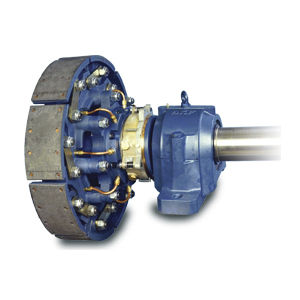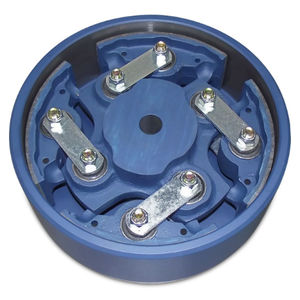
Disc clutch AirStartcentrifugalpneumatic

Add to favorites
Compare this product
Characteristics
- Type
- disc, centrifugal
- Operation
- pneumatic
Description
The clutch drum is attached to the prime mover, the hub carrying the flexibly mounted lined shoes forming the driven half coupling. To initiate engagement, the clutch shoes are moved outwards into pressure contact with the rotating drum air thrusters built into the driven half hub.
This starts the driven half rotating, and as it accelerates the centrifugal effect causes the clutch shoe assemblies to press harder against the drum, giving progressively firmer engagement until after a few seconds the starting air pressure can be removed.
Specification
When up to operating speed the clutch transmits normal power, being "locked up" by centrifugal force and therefore operates without further slip.
Should an overload occur sufficient to cause clutch slip or to slow the prime mover significantly, the clutch disengages immediately protecting the transmission from the high inertia torque which would otherwise be applied by the rotating masses of the engine, electric motor or turbine rotor.
Clutch disengagement (if required) makes use of the this feature. It is effected by a disc brake operating on the driven hub. Thus, when the driven machine is stationary, it is also secured against rotation by the brake. This is an essential requirement in marine propulsion or wherever the load can drive back, as in centrifugal pumps.
The disc brake is necessary if the clutch has to be disengaged whilst the machinery is running or if the driven shaft must be held stationary whilst the clutch is disengaged. (If the driven shaft can be rotated by the load, it will try to engage the clutch, making a brake essential).
Catalogs
No catalogs are available for this product.
See all of TWIFLEX‘s catalogsRelated Searches
- Flexible shaft coupling
- Shafts coupling
- Friction brake
- Flange shaft coupling
- Spring brake
- Disc brake
- Torque shaft coupling
- Friction clutch
- Friction brake caliper
- Disc brake caliper
- Engine shaft coupling
- Spring brake caliper
- Hydraulic brake
- Pneumatic brake caliper
- Pneumatic brake
- Maintenance-free shaft coupling
- Disc clutch
- Spring clutch
- Clamp coupling
- Pneumatic clutch
*Prices are pre-tax. They exclude delivery charges and customs duties and do not include additional charges for installation or activation options. Prices are indicative only and may vary by country, with changes to the cost of raw materials and exchange rates.



